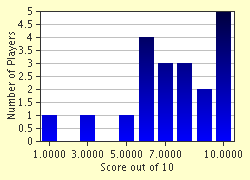Quiz Answer Key and Fun Facts
1. Which three South American countries surround Paraguay (coloured yellow on the map)?
2. Asunción, the country's capital, sits just across from Argentina on the eastern (left) bank of the Rio Paraguay. Which of the following most accurately describes its climate?
3. Historically, what has been the quickest way to travel around the country?
4. Which native people did the Spanish encounter in the 16th century in what is now Paraguay?
5. The country has two main geographical regions: the Paraneña to the East and the Chaco to the West. Which river creates a natural boundary between the two regions?
6. Thanks to the Spanish, religion has left its mark in the form of some photogenic ruins. Which religious group originally built the missions?
7. Which natural resource is the basis of virtually all of Paraguay's electrical supply?
8. Guaira Falls on the Paraná River was once amongst the world's largest waterfalls by volume. Since 1982 this is no longer the case. Why?
9. Native to Paraguay, what of the following is a natural habitat of the capybara (Hydrochoerus hydrochaeris)?
10. The dried leaves of the yerba mate (Ilex paraguariensis) are traditionally used with a hollow gourd and bombilla (shown in the photo). How are the leaves used?
Source: Author
suomy
This quiz was reviewed by FunTrivia editor
Tizzabelle before going online.
Any errors found in FunTrivia content are routinely corrected through our feedback system.

